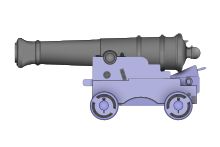
A carronade is a short smoothbore cast-iron cannon which was used by the Royal Navy. It was first produced by the Carron Company, an ironworks in Falkirk, Scotland, and was used from the mid-18th century to the mid-19th century. Its main function was to serve as a powerful, short-range, anti-ship and anti-crew weapon. The technology behind the carronade was greater dimensional precision, with the shot fitting more closely in the barrel thus transmitting more of the propellant charge's energy to the projectile, allowing a lighter gun using less gunpowder to be effective.

In 1603 all English warships with a complement of fewer than 160 men were known as 'small ships'. In 1625/26 to establish pay rates for officers, a six-tier naval ship rating system was introduced. These small ships were divided into three tiers: fourth-, fifth- and sixth-rates. Up to the end of the 17th century, the number of guns and the complement size were adjusted until the rating system was actually clarified. A 'fourth-rate' was nominally a ship of over thirty guns with a complement of 140 men.

In the 18th century and most of the 19th, a sloop-of-war in the Royal Navy was a warship with a single gun deck that carried up to eighteen guns. The rating system covered all vessels with 20 guns and above; thus, the term sloop-of-war encompassed all the unrated combat vessels, including the very small gun-brigs and cutters. In technical terms, even the more specialised bomb vessels and fireships were classed as sloops-of-war, and in practice these were employed in the sloop role when not carrying out their specialised functions.

Steam frigates and the smaller steam corvettes, steam sloops, steam gunboats and steam schooners, were steam-powered warships that were not meant to stand in the line of battle. The first such ships were paddle steamers. Later on the invention of screw propulsion enabled construction of screw-powered versions of the traditional frigates, corvettes, sloops and gunboats.

The rating system of the Royal Navy and its predecessors was used by the Royal Navy between the beginning of the 17th century and the middle of the 19th century to categorise sailing warships, initially classing them according to their assigned complement of men, and later according to the number of their carriage-mounted guns. The rating system of the Royal Navy formally came to an end in the late 19th century by declaration of the Admiralty. The main cause behind this declaration focused on new types of gun, the introduction of steam propulsion and the use of iron and steel armour which made rating ships by the number of guns obsolete.
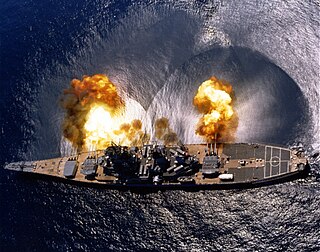
Naval artillery is artillery mounted on a warship, originally used only for naval warfare and then subsequently used for more specialized roles in surface warfare such as naval gunfire support (NGFS) and anti-aircraft warfare (AAW) engagements. The term generally refers to powder-launched projectile-firing weapons and excludes self-propelled projectiles such as torpedoes, rockets, and missiles and those simply dropped overboard such as depth charges and naval mines.
Naval artillery in the Age of Sail encompasses the period of roughly 1571–1862: when large, sail-powered wooden naval warships dominated the high seas, mounting a large variety of types and sizes of cannon as their main armament. By modern standards, these cannon were extremely inefficient, difficult to load, and short ranged. These characteristics, along with the handling and seamanship of the ships that mounted them, defined the environment in which the naval tactics in the Age of Sail developed.

The Bretagne was a fast 130-gun three-deck ship of the French Navy, designed by engineer Jules Marielle. Built as a new capital ship meant to improve on the very successful Océan class, while avoiding the weaknesses found on Valmy, she retained most of the Océan's design, and incorporated the philosophy of "fast ship of the line" pioneered by Napoléon, with a rounded stern and a two-cylinder, 8-boiler steam engine allowing her a speed of 13.5 knots. The propeller could be retracted to streamline the hull when sailing under sail only.

Aréthuse was a 46-gun frigate of the French Navy. She served during the Napoleonic Wars, taking part in a major single-ship action. Much later the vessel took part in the conquest of Algeria, and ended her days as a coal depot in Brest, France.

Invincible was a first-rate ship of the line of the French Royal Navy.

The 36-pounder long gun was the largest piece of artillery mounted on French warships of the Age of Sail. They were also used for Coastal defense and fortification. They largely exceeded the heaviest guns fielded by the Army, which were 24-pounder long guns. The nominal weight of shot was 36 French livres, 17.6 kg (38.8 lb).
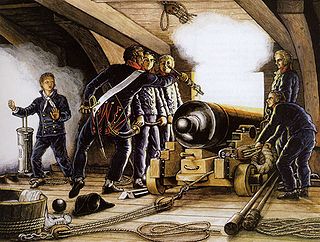
The 18-pounder long gun was an intermediary calibre piece of naval artillery mounted on warships of the Age of Sail. They were used as main guns on the most typical frigates of the early 19th century, on the second deck of third-rate ships of the line, and even on the third deck of late first-rate ships of the line.
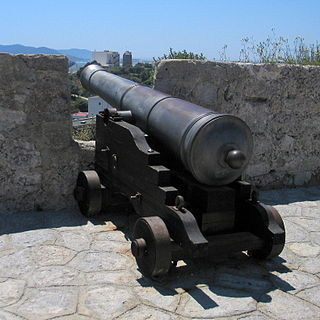
The 24-pounder long gun was a heavy calibre piece of artillery mounted on warships of the Age of Sail. 24-pounders were in service in the navies of France, Spain, Great Britain, the Netherlands, Sweden, and the United States. They were comparable to the Canon de 24 Gribeauval used by the French Army as its largest piece of siege artillery. 24-pounders were used as main guns on the heaviest frigates of the early 19th century and on fourth-rate ships of the line, on the second deck of first-rate ships of the line, and on the second deck of a few large third-rates.

The 12-pounder long gun was an intermediary calibre piece of artillery mounted on warships of the Age of Sail. They were used as main guns on the most typical frigates of the early 18th century, on the second deck of fourth-rate ships of the line, and on the upper decks or castles of 80-gun and 120-gun ships of the line. Naval 12-pounders were similar to 12-pound Army guns in the Gribeauval system: the canon lourd de 12 Gribeauval, used as a siege weapon, and the canon de 12 Gribeauval, which was considered a heavy field artillery piece.

A gunport is an opening in the side of the hull of a ship, above the waterline, which allows the muzzle of artillery pieces mounted on the gun deck to fire outside. The origin of this technology is not precisely known, but can be traced back to the late 15th century, with the appearance of artillery in naval warfare. Ships featuring gunports were said to be pierced, since the ports were cut through the hull after the construction.
The 30-pounder short gun was a piece of artillery mounted on French warships of the Age of sail. They were the middle-sized component of the unified system standardised on the 30-pounder calibre, replacing both the 24-pounders and 18-pounders in many usages.
Konstantin was a 74-gun Fershampenuaz-class ship of the line built for the Imperial Russian Navy in the mid-1830s. The ship was assigned to the Baltic Fleet for her entire career. She was one of the ships deployed to Denmark during the First Schleswig War of 1848–50 to help preserve Denmark's territorial integrity against Prussia. The ship was converted to steam power in 1852–54 and cruised the Baltic Sea in 1857–60 before she was placed in ordinary. Konstantin was stricken from the navy list in 1864 and sold for scrap.
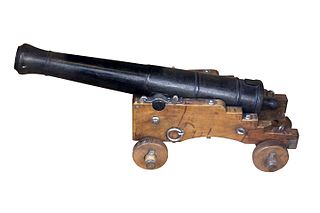
The 8-pounder short gun was a light calibre piece of artillery mounted on French warships of the Age of sail. They were used as main guns on light ships of the early 19th century, and on the quarterdeck and forecastle of ships of the line. They were similar in design to the Canon de 8 Gribeauval.

The Khrabryi class was a pair of ships of the line built for the Black Sea Fleet of the Imperial Russian Navy in the 1840s and early 1850s. The class comprised two ships: Khrabryi and Imperatritsa Maria. The two ships were built as part of a naval expansion program aimed at strengthening the Black Sea Fleet during a period of increased tension with Britain and France over the continued decline of the Ottoman Empire. Both ships saw active service during the Crimean War, with Imperatritsa Maria serving as Pavel Nakhimov's flagship at the Battle of Sinop in November 1853, where the Russians annihilated an Ottoman squadron. The two ships were withdrawn to Sevastopol after the British and French intervention and were trapped there during the Siege of Sevastopol until 1855, when both were scuttled to block the harbor entrance.

The 32-pounder guns were sets of heavy-caliber pieces of artillery mounted on warships in the last century of the Age of sail, during the 18th and early 19th centuries. It was usually the most powerful armament on a warship. The British version fired a 14.4 kilogram projectile at about 487 meters per second, for a muzzle energy of over 1.7 million joules. They were most famous being mounted on HMS Victory of the Royal Navy. Such a powerful gun with a large weight of shot posed serious damage to enemy ships.
